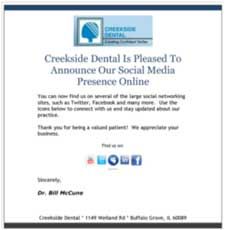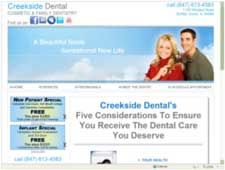Recommendations from friends are still a big part of how patients find a new dentist, but in a time when the whole world is much more closely connected through the Internet those “recommendations” and “friends” are available from a much wider array of sources, all of which are easily searchable.
Recommendations from friends are still a big part of how patients find a new dentist, but in a time when the whole world is much more closely connected through the Internet those “recommendations” and “friends” are available from a much wider array of sources, all of which are easily searchable.
Gone are the days when people would flip through a massive phone book to finds the pages of ads from dentists in their area. Those books still exist, but these days prospective patients are far more likely to conduct their search via a computer at home or at work, or even from the rapidly growing number of Internet-enabled cell phones.
They might start the search with the name of a specific dentist they heard about from a friend, or they might simply be searching for a dentist in a specific city, but either way they are likely to start at an Internet search engine such as Google, Yahoo or the newest to launch, Bing.
Search results
In the not too distant past, the results of such Web searches might turn up a practice’s Web site, or possibly a listing for the practice at an online “phone book” type site that lists contact information for different business categories. However, these days the search results are likely to include the practice Web site along with additional online outlets for the practice.
These can include practice controlled social media profiles on a site such as Facebook, a practice’s micro-blogging presence on a site such as Twitter, or content the practice does not control such as user reviews on a site such as Yelp!. Practices can either test the waters, or dive head first into the world of social media, depending on their comfort level and if they feel it’s a fit for their practice. But even those who are not yet up to setting up a blog should at least be up to date on what current and former patients are saying about them on the Web.
“Searches for a dentist that include the term ‘review’ are being conducted nearly as frequently as just the name and location of the dentist, so these review sites are clearly a force to be reckoned with,” said Daniel A. Bobrow, MBA, president of American Dental Marketing.
Watching yourself online
“These alerts, while not perfect, are a convenient way to keep up to date on what is being posted…”
-Danny Bobrow
Bobrow recommends that his clients set up Google Alerts, a free service that sends them an e-mail whenever keywords such as the practice’s or the doctor’s name appears in news articles or recently posted online reviews. “These alerts, while not perfect, are a convenient way to keep up to date on what is being posted, which is especially important if a patient posts a negative review,” he said.
Most review sites will not remove negative reviews, but they will allow the business to post a response. Bobrow recommends reaching out to the patient who posted the negative comments to address the concerns, and then posting the results of those efforts to accommodate the patient.
Rita Zamora, a consultant who blogs about relationship-focused dental marketing at dentalrelationshipmarketing.com agrees that dentists need to be actively policing their online reputation. Part of that is responding to negative comments, but another part of that effort can involve creating a more robust Web presence so positive information outranks a negative review when someone searches for your practice.
“When you’re actively participating in social marketing on the Web and have a lot of positive information out there, it will help to drown out some of those hopefully very sparse negative comments that exist out there,” she said.
Taking control
The fastest way to spread a lot of positive information online is to create practice profiles on the social media networks. However, practices will only see the full benefit of those networks if they are putting in the time to actively participate in the online communities, Zamora said. Because of this, social media marketing will not be for everyone.
For those practices that are comfortable online and willing to dedicate the minimum of an hour or so a week to social media efforts, Zamora believes these efforts can pay off by creating stronger bonds with existing patients and showing an inviting presence to new patients. A practice can use a Facebook profile to post updates and specials that only fans of the profile can receive, and the page can also be used to show off small bits about the personalities of the practice’s staff.
“I think one of the most challenging situations that’s going to come up for dentists using Facebook is that there is a fine line between being too salesy and really socializing in a community,” she said. “They do want to have that traditional type of information available, but when they’re researching who is going to be the best dentist for them, they want to see a little bit about your personality and how it’s going to feel to interact with and relate to you when they come into your office.”
Maintaining a profile on Facebook gives a practice the opportunity to interact with patients on a number of levels. Engaged patients might be more likely to post a nice online thank you after an appointment, and Bobrow said dentists should be active in asking new patients to post a review about their positive experience. However, Zamora cautions about soliciting positive reviews, as she believes savvy Web users will be able to tell if a review is not genuine. Both agree that the best approach is to be sure search engine results feature far more positive than negative reviews.
Reaching out
While Facebook and similar sites can provide a terrific place for patients to get a sense of both the practice and the people behind the practice, micro-blogging site Twitter can provide practices with an easy way to provide current and prospective patients with practice-related news and announcements. The site lets practices post short notes that other users who’ve signed up to follow that practice’s Twitter feed can view online or receive as text messages on their phone.
A Twitter account can be useful to dentists who want to follow the latest news from media users such as Dental Products Report, or by following the feed from a manufacturer using Twitter, a practice can stay up to date on the most recent information on products and services. However, the site can also be very useful in helping a practice grow its online presence.
“It’s just a different avenue of marketing. It’s nice to be on it because if somebody happens to be reading a post we put on it, they can communicate with us right there on Twitter,” said Melinda Baugh, office manager at Brazos Family Dentistry in Waco, Texas. “We want to have an online presence where people can find us, and just having a Web site sometimes doesn’t get you there.”
Baugh said her practice started using Twitter as a promotional tool in March and the practice’s feed (twitter.com/WacoDentist) quickly amassed more than 400 followers. She manages the practice’s posts and includes everything from specials for their patients to links to interesting dental news stories.
Thus far Baugh has used the site to communicate with people from around the world, and thinks it is a useful tool for connecting with a range of people. Still the focus of her efforts will remain on providing information for people in her community because, “local followers equal potential patients,” she said.
Keep it real
Keeping up with the Twitter feed and the practice’s recently created Facebook page does take a bit of time, but Baugh said it really only adds up to 15 to 30 minutes a day. A self-described, “computer person” Baugh said it is not difficult to stay current and keeping the practice feed populated with fresh posts, but she does occasionally make her posts from home after the workday is over.
It is that genuine interaction and the dedication to making sure the practice is active with their social media efforts that are going be beneficial to the practice, Zamora said. While being on the sites everyday is not necessarily a requirement, she said spending about an hour a week to manage a practice’s social media presence is probably a good idea.
Bobrow and Zamora both agree that any practice jumping into social media to expand its online presence should have one staff member as the point person for the efforts. It doesn’t need to be the doctor, but should be someone who understands how to use the systems and has the good sense to keep things on a professional level.
Baugh ended up handling it for her practice because of her role managing the office and her comfort with computers. If a practice does not have someone comfortable with personal interaction via the Internet, social media marketing may not be a good fit, Zamora said. While every practice should stay aware of reviews-both positive and negative-efforts to expand a practice’s visibility through social networking should only be undertaken by those who can be dedicated to the efforts.
“Social media amplifies a dentist and a practice’s patient relation skills,” Zamora said. “Someone who has natural people skills may find social media marketing much more enjoyable and a lot easier than someone who doesn’t really appreciate the nuances of networking.”
Noah Levine is a senior editor for DPR. Contact him at nlevine@advanstar.com.






